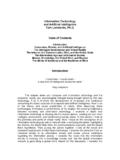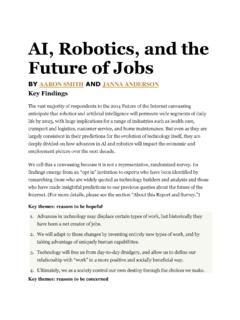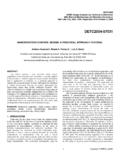Transcription of Cybernetics and Second-Order Cybernetics
1 In: Meyers (ed.), Encyclopedia of Physical Science & Technology (3rd ed.), (Academic Press, New York,2001). Cybernetics and second -OrderCyberneticsFrancis HeylighenFree University of BrusselsCliff JoslynLos Alamos National Development of 1B . second order 4II. Relational and 5B .Variety and and 8B . 9C . 11IV.
2 Goal-Directedness and 12B .Mechanisms of 13C .The Law of Requisite of a Control 17V.
3 18B .The Modelling and 23 GlossaryVariety: a measure of the number of possible states or actionsEntropy: a probabilistic measure of varietySelf-organization.
4 The spontaneous reduction of entropy in a dynamic systemControl: maintenance of a goal by active compensation of perturbationsModel: a representation of processes in the world that allows predictions2 Constructivism: the philosophy that models are not passive reflections of reality, but activeconstructions by the subjectCybernetics is the science that studies the abstract principles of organization in complexsystems. It is concerned not so much with what systems consist of, but how they focuses on how systems use information, models, and control actions to steertowards and maintain their goals, while counteracting various disturbances.
5 Being inherentlytransdisciplinary, cybernetic reasoning can be applied to understand, model and designsystems of any kind: physical, technological, biological, ecological, psychological, social, orany combination of those. Second-Order Cybernetics in particular studies the role of the(human) observer in the construction of models of systems and other Development of from the Greek kybernetes, or "steersman", the term " Cybernetics " first appears inAntiquity with Plato, and in the 19th century with Amp re, who both saw it as the science ofeffective government.
6 The concept was revived and elaborated by the mathematician NorbertWiener in his seminal 1948 book, whose title defined it as " Cybernetics , or the study ofcontrol and communication in the animal and the machine". Inspired by wartime and pre-warresults in mechanical control systems such as servomechanisms and artillery targetingsystems, and the contemporaneous development of a mathematical theory of communication(or information) by Claude Shannon, Wiener set out to develop a general theory oforganizational and control relations in Theory, Control Theory and Control Systems Engineering have since developedinto independent disciplines.
7 What distinguishes Cybernetics is its emphasis on control andcommunication not only in engineered, artificial systems, but also in evolved, natural systemssuch as organisms and societies, which set their own goals, rather than being controlled bytheir as a specific field grew out of a series of interdisciplinary meetings held from1944 to 1953 that brought together a number of noted post-war intellectuals, includingWiener, John von Neumann, Warren McCulloch, Claude Shannon, Heinz von Foerster, Ashby, Gregory Bateson and Margaret Mead.
8 Hosted by the Josiah Macy , these became known as the Macy Conferences on Cybernetics . From its originalfocus on machines and animals, Cybernetics quickly broadened to encompass minds ( in thework of Bateson and Ashby) and social systems ( Stafford Beer's managementcybernetics), thus recovering Plato's original focus on the control relations in the 1950s, cybernetic thinkers came to cohere with the school of General SystemsTheory (GST), founded at about the same time by Ludwig von Bertalanffy, as an attempt tobuild a unified science by uncovering the common principles that govern open, evolvingsystems.
9 GST studies systems at all levels of generality, whereas Cybernetics focuses morespecifically on goal-directed, functional systems which have some form of control there remain arguments over the relative scope of these domains, each can be seen aspart of an overall attempt to forge a transdisciplinary "Systems Science".Perhaps the most fundamental contribution of Cybernetics is its explanation of purposiveness,or goal-directed behavior, an essential characteristic of mind and life, in terms of control andinformation.
10 Negative feedback control loops which try to achieve and maintain goal stateswere seen as basic models for the autonomy characteristic of organisms: their behavior, whilepurposeful, is not strictly determined by either environmental influences or internal dynamicalprocesses. They are in some sense "independent actors" with a "free will". Thus cyberneticsforesaw much current work in robotics and autonomous agents. Indeed, in the popular mind,"cyborgs" and " Cybernetics " are just fancy terms for "robots" and "robotics".






